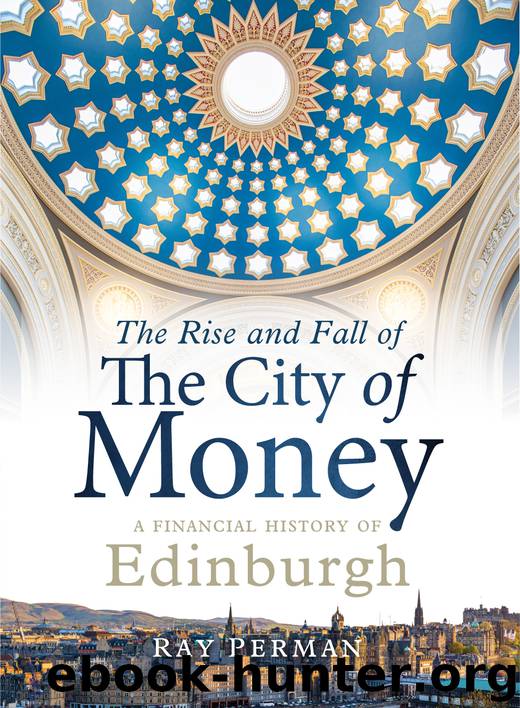The Rise and Fall of the City of Money by Ray Perman

Author:Ray Perman
Language: eng
Format: epub
Publisher: Birlinn
* See Chapter 10 above.
Part 3
Modernisation and internationalisation
22
Financing American railroads
THE COLLAPSE OF the Western and the City of Glasgow banks reinforced the conservatism of the Edinburgh banking cartel, which entered a decades-long period of complacency. Seven large banks – five in Edinburgh, which accounted for 70 per cent of the market,1 plus the Union and Clydesdale in Glasgow – now dominated the system, moving ‘more or less in step, for more than 70 years’.2 They grew, but all were organised in much the same way, and, through the general managers’ committee, agreed their interest rates and charges. Only the location and distribution of their branches differentiated them and competition between them for customers was practically non-existent.3 The directors of these banks were reinforced in their unshakable belief that their way was the only correct way. The failed Glasgow banks had not only been incompetent, but they had invested their depositors’ money in wildly uncertain foreign ventures. The establishment banks were not going to follow them.
Both the Western and the City of Glasgow banks had made substantial advances to American railway companies. The railway boom in the United States was producing massive economic benefits and there were fortunes to be made investing in shares and bonds. But it was also a fiercely competitive market, full of traps for the unwary. Predicting winners and losers was beyond the capabilities of a Glasgow-based board and management. City of Glasgow had sought to tap into local knowledge by opening an agency in New York, headed by the chairman’s brother, but early investments had not gone well. As part of their support in 1857, the establishment banks had insisted City of Glasgow close its US office, but the bank was in too deep to take its losses without endangering its survival and over the next 20 years a variety of complex schemes intended to extricate it merely increased the deficit.4 When the bank was liquidated, its losses in America were only a small fraction of its total liabilities, but it had been tempted into a faraway market in which it was ill equipped to understand the risks, let alone control them. The other banks accepted the lesson.
If banking was about to become boring, another part of the finance sector was about to become exciting. Bankers may have averted their eyes, but other individuals had seen the potential in the fast-developing US economy. Like Britain, it had experienced a railway mania, but by the last quarter of the nineteenth century the market was beginning to mature. Two Scotsman had realised independently that there was money to be made and found novel ways to mitigate the risk.
The first was Robert Fleming, a shining example of the ‘lad o’ pairts’, a bright boy from a modest family who won a bursary to Dundee High School, where he excelled at mathematics and bookkeeping. At 13 he began as an office boy to a merchant in the Cowgate, but by his late teens was holding responsible jobs in the offices
Download
This site does not store any files on its server. We only index and link to content provided by other sites. Please contact the content providers to delete copyright contents if any and email us, we'll remove relevant links or contents immediately.
International Integration of the Brazilian Economy by Elias C. Grivoyannis(57427)
The Radium Girls by Kate Moore(10933)
Turbulence by E. J. Noyes(7064)
Nudge - Improving Decisions about Health, Wealth, and Happiness by Thaler Sunstein(6650)
The Black Swan by Nassim Nicholas Taleb(6219)
Pioneering Portfolio Management by David F. Swensen(5620)
Rich Dad Poor Dad by Robert T. Kiyosaki(5175)
Zero to One by Peter Thiel(4841)
Man-made Catastrophes and Risk Information Concealment by Dmitry Chernov & Didier Sornette(4759)
Secrecy World by Jake Bernstein(3794)
Millionaire: The Philanderer, Gambler, and Duelist Who Invented Modern Finance by Janet Gleeson(3583)
Skin in the Game by Nassim Nicholas Taleb(3489)
The Age of Surveillance Capitalism by Shoshana Zuboff(3436)
The Money Culture by Michael Lewis(3298)
Skin in the Game: Hidden Asymmetries in Daily Life by Nassim Nicholas Taleb(3280)
Bullshit Jobs by David Graeber(3194)
The Dhandho Investor by Mohnish Pabrai(3181)
The Wisdom of Finance by Mihir Desai(3093)
Blockchain Basics by Daniel Drescher(2902)
